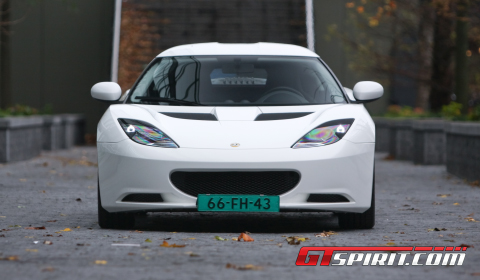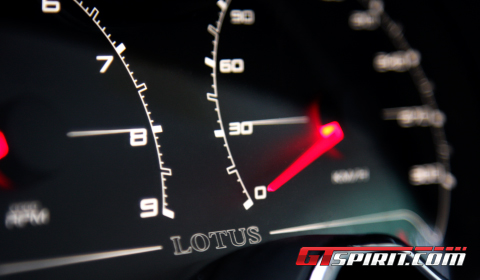Experiencing a Lotus is one of those automotive thrills which can hardly be described by just writing a single road test. Still we will try to share our experience with you and elaborate on the first all-new Lotus for nearly 15 years; the Evora.
Built to take on the likes of the Porsche Cayman and 911, the Evora is the world’s only mid-engined 2+2. The British sports car slots into the Lotus range above the Elise and several of the new upcoming models shown to us all at the Paris Motor Show. Lotus has lived on the razor’s edge most of its 58-year existence but has enjoyed some of its greatest sales since the introduction of the well-known Elise in 1995. 15 years and more than thirty Elise variants later, the company saw the need to move the brand up-market. So they did and the Evora was the result.
Based on a familiar setup, the Evora expands on the all-out track-tuned Elise theme with its aluminum chassis significantly revised. It has greater torsional strength and has a three-part structure. The Evora is roughly five inches shorter than the 911 but still manages to squeeze in similarly sized tiny back seats that are designed to fit very small adults or children up to about ten years old. In most cases you will only use them for additional luggage space making the car a superb weekend drive.

The main power source for the standard Evora is a Toyota DOHC 3.5 liter VVT-I V6 producing 276hp and 258lb-ft of torque. The sports car, which is longer, wider and almost 408kg or 900 pounds heavier than the hyper-focused Elise, reaches 100km/h (62mph) in 5,1 seconds and has a top speed of 261km/h (162mph). The six speed manual gearbox – also sourced from Toyota – converts the power to the rear wheels.
Especially at low speeds when taking off from a stand still you hear some squeak in the gearbox. But this type of sound adds to the Evora’s character rather than detracting the driver’s sheer pleasure. Oh and for those interested. An automatic gearbox is only available on the IPS variant, available in 2011.
The sheer speed from the power train is smooth. Even though it is fast, it is never blisteringly. The Evora sounds great and can give you a sharper throttle response if you have chosen the Sport pack from the option list. When you press the sport button the redline is set at 7,000rpm, the normal setup is 6,600rpm. In some challenging circumstances there is a definite need for more power. Lotus clearly left some room for a more powerful version, which has become the supercharged S version. The standard Evora is a great sports car, but we generally requested more power, especially in relation to the brilliant handling and excellent ride.
The 2010 Lotus Evora is most at home on tight, twisting roads. Like its smaller Elise and Exige cousins, the Evora knifes through turns with uncommon precision and otherworldly levels of grip. You can blast it from corner into corner. Not once did the tires complain during our day behind the wheel, with no understeer or oversteer.
The steering is ultra precise and little compromised by the Evora’s weight or sissified mission. There is no body lean whatsoever and the ride is more comfortable than we anticipated. Braking is similarly precise, with immediate bite and extremely linear behavior.

The exterior design is stunning. It resembles its ancestors, but incorporates some stylish kind of looks that direct competitors lack. The Evora – offered in one single trim level – measures 12cm wider, 10cm inches taller and 55cm longer than the Elise, but still belongs to the same British family. Standard equipment includes 18 inch alloy front wheels, 19 inch rear wheels, bi-xenon headlights and heated exterior mirrors.
Stepping into the new top-of-the-line Lotus, one is instantly aware that the Spartan aspect of a Lotus hasn’t left. Even though, we were amazed what a little leather and sound-deadening material will do for your perception as a driver inside the Evora. It even has narrower door sills and a 2.5 inch higher seating position, making it far easier to get into and out of. Overall, the stylish cabin is a major leap forward for Lotus. Still, it is not perfect. Minor ergonomical flaws are still available, such as the hardly visible backlighting of some of the buttons in the dashboard.
Additionally, there are three main option sets available. The Premium package adds accent lighting, a center armrest between the front seats, premium floor mats and leather trim throughout the cabin. The Sport package features selectable sport modes, enhanced throttle response, a higher rpm limit, a rear underbody diffuser, titanium exhaust tips and cross-drilled brake rotors with black-painted calipers. The Technology package includes cruise control, rear parking sensors, Bluetooth and an upgraded stereo with DVD playback, a 7-inch touchscreen display, navigation and a USB port.
After a full day of driving you are left with a true Lotus experience, something more original, more stylish and some sort of raw driving experience you would not directly come across when you drive a similar priced sports car from Zuffenhausen. The Evora is available for two types of customers; those moving up from the Lotus ladder, but also people moving over from other brands.
In the end we can say that it truly shows some new type of drivability, less raw known to Lotus enthusiasts and still never mainstream, but positioned at a wider audience. The Evora is a new type of Lotus, one that leads the way into the brand new future of the car manufacturer and acts as a basis for a wide variety of upcoming models.
Thanks to Vanderkooi Sports cars Dutch dealer for Lotus, Caterham and Noble.





































Very nice article, photos and video.